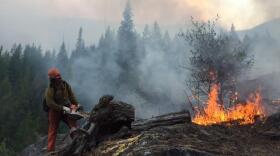In the summer of 1910 - 115 years ago this week - weather and forest conditions were eerily similar to those gripping us now = an early, dry spring, little snow runoff, gaspingly hot temperatures and extreme drought. And hundreds of wildfires suddenly merged into the most voracious fire storm ever.
Back then, the US Forest Service was more an idea than a fact. Forest rangers were sent out on foot with an ax, and told they were responsible for hundreds of square miles of timberland marching across corrugated landscapes.
On August 20th, 1910, more than a thousand wildfires dotted northern Idaho, western Montana and southern BC - some set by logging crews, some by lightning, some by hot locomotive cinders. And then came a dry front with winds of 50 miles an hour and above, much like the front which whipped through the same area last Friday.
In a blink, hundreds of fires merged into one gigantic firestorm which eventually blackened more than 3-million acres and killed 87 people, including a 28-man crew near Setzer Creek outside Avery Idaho.
That was a time before they started naming fires, so for years after, this inferno was known simply as the Fire of 1910.
Officials of the fledgling forest service managed to round up 10-thousand men - college boys, drifters from Spokane and miners - to fight the flames. But it was not until another front blew in - this one laden with rain - that the Big Burn, as author Timothy Egan labeled it, was finally smothered.
Historians noted that 1910 was the driest year in anyone's memory when snow melted early and spring rains never came, swift-running rivers slowed to a crawl and huge piles of forest debris littered forest floors.
Some might say we've come full circle.



